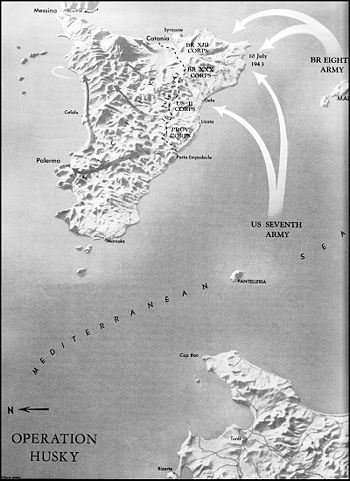World War II: Difference between revisions
imported>Richard Jensen (Husky map) |
imported>Richard Jensen (map) |
||
| Line 25: | Line 25: | ||
;Continuation War | ;Continuation War | ||
;Battle of Sicily | ;Battle of Sicily | ||
[[Image:Ww2-husky.jpg|Operation Husky: Invasion of Sicily, 1943]] | [[Image:Ww2-husky.jpg|thumb|350px|Operation Husky: Invasion of Sicily, 1943]] | ||
;Italian Campaign | ;Italian Campaign | ||
[[Image:Ww2-avalanche.jpg|thumb|350px|Invasion of Italy 1943]] | |||
;Battle of Normandy | ;Battle of Normandy | ||
;Northwest Europe Campaign | ;Northwest Europe Campaign | ||
Revision as of 10:13, 25 June 2008
World War II 1939-1945
Name
In the Commonwealth nations, official histories of the various militaries universally refer to the conflict as the Second World War. This style also follows literaly translations of other nations' official designation for the conflict, e.g. Zweiter Weltkrieg in German. The official histories of the United States armed forces refer to the conflict as World War II or World War Two, and that term is now often used in Canada and the UK as well.
Parts of the world, especially Latin America, were largely unaffected directly by the conflict, with significant concentrations of activity in the European, north African, Russian, and Pacific theatres.
Causes and Diplomacy
Land Warfare
Europe
Both Germany and the Soviet Union participated in an armed invasion and occupation of Poland, beginning with an initial German attack on September 1, 1939. The German invasion has often been referred to as "blitzkrieg" (lighting war) but in actual fact the German Army used traditional concepts of warfare wedded to existing technologies in order to achieve spectacular results against the relatively unprepared Poles.
France and Great Britain, having sworn to defend Poland, declared war on Germany but in the end were unable to provide material assistance. The Soviet Union launched its own invasion of Polish territory, and Slovak troops also participated in operations on Polish soil. Poland officially capitulated in August.
- Phony War
- Winter War
- Invasion of Norway
- France and the Low Countries
- Battle of Britain
- Invasion of Greece
- Invasion of Yugoslavia
- Operation Barbarossa
- Continuation War
- Battle of Sicily
- Italian Campaign
- Battle of Normandy
- Northwest Europe Campaign
- Southern France
- Crossing the Rhine
- Battle of Berlin
China
see CBI
Southwest Pacific
see World War II, Pacific see Battle of the Atlantic
Major battles
- Pearl Harbor, battle of
- Midway, battle of
- Philippine Sea, battle of
- Battle of the Atlantic
- Leyte Gulf, battle of
- Iwo Jima, battle of
- Okinawa, battle of
Major developments
On December 8, 1941, the battleship, with large guns as its primary weapon, had become secondary to the aircraft carrier as the dominant ship of the world's navies. the last combat between battleships was the Battle of Surigao Strait on 25 October 1944.
Naval aviation, primarily carrier-based but with some significant activity by land-based aircraft, became the centerpiece of combat at sea, although submarines, primarily operating alone, was also decisive. Defense against aircraft attack also advanced quickly, with the key technologies of radar, improved anti-aircraft artillery with proximity-fuzed shells, combat air patrol doctrine, and combat information center coordination. Defense was especially important against the first large-scale use of precision-guided munitions, or kamikaze aircraft with pilots intending to die with their airplanes crashing into ships.
Amphibious warfare doctrine and practice constantly improved.
replenishment at sea allowed U.S. fleets to operate for long periods, away from bases. This was a major force multiplier.
Air War
Economics
Financing
Production
Manpower
War Crimes
Holocaust
- see Holocaust
- see Holocaust denial
- see Turkey and the Holocaust
Resistance
Results and Aftermath
Japan
Total Japanese military fatalities between 1937 and 1945 were 2.1 million; most came in the last year of the war. Starvation or malnutrition-related illness accounted for roughly 80 percent of Japanese military deaths in the Philippines, and 50 percent of military fatalities in China. The aerial bombing of a total of 65 Japanese cities appears to have taken a minimum of 400,000 and possibly closer to 600,000 civlian lives (over 100,000 in Tokyo alone, over 200,000 in Hiroshima and Nagasaki combined, and 80,000-150,000 civilian deaths in the battle of Okinawa). Civilian death among settlers who died attempting to return to Japan from Manchuria in the winter of 1945 were probably around 100,000.[1]


